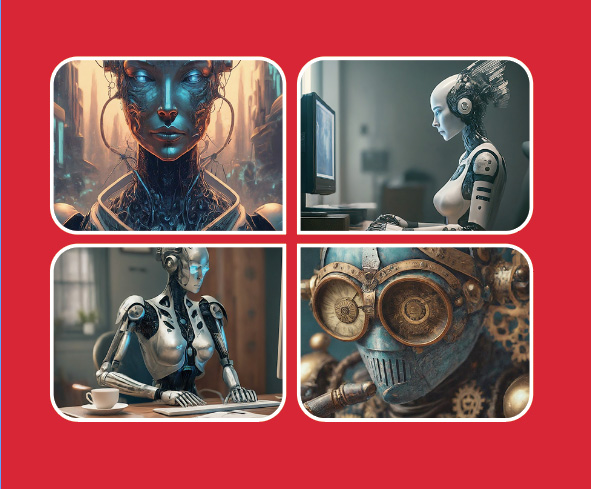ABOVE—Image served up for the AI prompt “Futuristic artificial intelligence mesh robot pointing at the screen of a computer to help solve a problem while a businesswoman relaxes in a chair watching with a smile.”
Tools that you can use today
AI or “Artificial intelligence” has been all the hype in recent years, specifically with the release of publicly available AI tools like OpenAI’s popular ChatGPT, Google Cloud Speech-to-Text, Gemini for Google Workspace, and my personal favorite, Grammarly. But how do you choose the AI tools that are practical for your everyday use? It’s simple—first, you define the need and then find the solution!
What AI tools work for me?
Choosing the right AI tools can supercharge your productivity, and I’ve found a few that have truly transformed my workflow. These tools not only make my life easier but also unleash my creativity, turning writing into a fun and engaging process.
Grammarly
For me, adding Grammarly to my arsenal of tools was a “no-brainer”. Grammarly uses a combination of AI and NLP (Natural Language Processing) to provide its grammar and spell-checking services. If there are no typos in this blog post or grammar errors, I can give Grammarly full credit as I am a terrible typer and horrible speller! (Thank you Grammarly for making me look smart!)
ChatGPT
I also have been experimenting with OpenAI’s ChatGPT engine. I have found it to be a great tool for generating checklists and step-by-step instructions. It also is helpful when I am working on creative writing projects or developing marketing language. For example, if I create a concept for a marketing campaign, I can quickly ask ChatGPT to provide alternative ideas based on my original concept. It is faster than a traditional creative meeting where we all gather in a conference room and throw out ideas to see what sticks. Ultimately, it triggers the creative process so I can generate additional ideas, making it the perfect “little helper” app. We are also a big fan of Copy.ai for the same reason—it empowers us to work fast and cost-effectively for our clients.
Speech-to-text
Yes, Please! As a terrible typer, I have grown to love all speech-to-text applications. I love that I can speak to my messenger app on my iPhone to send a complicated message quickly. The downside of that feature is when your Dad discovers he can send his life’s story to you over Messenger without the use of his fumbley thumbs. Then you are at the mercy of the “autocorrect” feature which can put quite a spin on any text message, if you know what I mean… I love the speech-to-text “Voice Typing” feature found in the Google Docs app. I am using it right now as I create this article! For me, it is much easier to dump a stream of consciousness into Google Docs so I don’t forget my initial thoughts, and come back later to clean it up using my favorite AI tool, Grammarly.
What AI tools are best for you?
There are so many AI tools to choose from that it would be nearly impossible to cover all of them in a single article. Instead, I’d like to cover some AI tools that have made a difference for myself or my clients.
ChatBots
A chatbot is a software application designed to simulate human conversation through text or voice interactions. Chatbots can perform various tasks, ranging from answering simple questions to providing customer support, executing commands, and even engaging in more complex interactions. They are commonly used in websites, messaging apps, and customer service platforms.
Chatbots have been around for years and were an early implementation of publicly available AI tools. The early chatbots required a lot of programming to teach the bot how you wanted it to respond to your customer’s inquiries. Today chatbots use AI in various ways to understand and respond to customers with less programming by using a dialog management technique.
Dialog management involves maintaining the flow of conversation between the chatbot and the user. AI-powered dialog managers enable chatbots to understand the context of the conversation, keep track of the state of the conversation, and generate appropriate responses based on the current context. It keeps the chatbot on target.

Other ways Chatbots use AI
Chatbots are revolutionizing the way we interact with technology, thanks to their advanced AI capabilities. By harnessing the following techniques, these digital assistants are becoming increasingly sophisticated in understanding and responding to human queries. Let’s explore some of the key AI methods that empower chatbots to deliver smarter, more personalized experiences.
Natural Language Processing. NLP enables chatbots to understand and interpret human language by parsing, analyzing, and understanding the meaning of the text input by users. NLP allows chatbots to extract intent, entities, and context from user messages, helping them to provide relevant and accurate responses.
Machine Learning. Chatbots often leverage machine learning algorithms to improve their performance over time. By training on larger sets of conversational data, chatbots can learn to recognize patterns in user queries and their responses. Machine learning enables chatbots to adapt and improve their accuracy and effectiveness based on experience.
Sentiment Analysis. Chatbots can use sentiment analysis techniques to analyze the sentiment or emotion expressed by a user’s text input. By understanding the emotional tone of user interactions, chatbots can tailor their responses accordingly, providing empathetic and personalized assistance to users. How does that make you feel?
AI-driven tools and platforms will assist creatives in generating, refining, and exploring new ideas, leading to innovative and compelling creative outputs.”
Knowledge Representation and Reasoning. Some chatbots use AI techniques to store and retrieve information from knowledge bases or databases. This allows chatbots to provide informative and relevant responses to user queries. Knowledge base applications are commonly found on web applications, but when powered by AI, can go one step further to helping customers find what they are looking for without having to interact with customer service, and therefore saving companies time and money.
Deep Learning. Deep learning techniques, such as neural networks, are increasingly being used in chatbots to improve their language understanding and generation capabilities. Deep learning models can learn complex patterns in textual data and generate more human-like responses, enhancing the conversational abilities of chatbots.
And what about voice command services like Alexa and Siri?
Amazon’s Alexa and Apple’s Siri use AI to interpret language and perform tasks like managing electronics in your home and finding the best Mexican food restaurant in your current location. What did we do before Siri? We got out the ol’ Yellow Pages and let our fingers do the walking!
How can Alexa streamline your day?
Alexa uses Natural Language Understanding (NLU) techniques powered by AI to interpret user input or commands. Alexa’s AI algorithms continuously analyze user interactions and feedback to adapt and improve its performance over time. I recently visited Puerto Rico (one of my favorite vacation spots) and my super host had wired his Airbnb up so that guests could tell the “Suite” how to control the lighting with some simple commands. “Alexa, turn Suite to 75%,” turned the lights down to 75%. “Alexa, turn Suite off,” turned the lights off. It took a minute to train myself how to use the commands, then I never had to touch the lights again. Of course, the host had to program the devices in his home to understand the commands, but it also gave me, as a guest, a sense of fun control over my environment. What could you program Alexa to do in your home to save a few minutes here and there?
How does Siri simplify your day?
Apple’s Siri also uses Natural Language Understanding (NLU) techniques to understand and interpret user queries and commands spoken in natural language. This enables users to interact with Siri using conversational speech, allowing for a more intuitive and user-friendly experience. Aside from quickly locating the closest Mexican food restaurant to the user’s current location, it can also be used to automate processes like setting reminders, sending messages, making calls, scheduling appointments, and much, much more.

Gemini for Google Workspace
This article was written before Gemini became available for Google Workplace, but it made a big enough impression on me that I wanted to mention it here. Gemini is great for composing quick messages via email. I use the integrated search which I find handy while I am in my Gmail account so I can stay focused. The summarize email tool is great for turning a long-winded email into an actionable to-do list. It just might replace ChatGPT for me!
Future of AI
You’ve probably been using AI for quite some time and just didn’t realize it. Here are some key areas where AI is expected to make significant contributions in the future:
Enhanced Automation. AI will continue to drive automation across industries, revolutionizing processes and workflows. This includes tasks such as manufacturing, logistics, customer service, healthcare diagnostics, and more, leading to increased efficiency, productivity, and cost savings. What part of your business model is repetitive and could benefit from AI workflow automation?
Personalized Experiences. AI will enable highly personalized experiences including personalized recommendations, content curation, product recommendations, and targeted advertising. This will enhance user engagement and satisfaction by delivering tailored experiences based on individual preferences and behaviors. No more looking at ads you have no interest in seeing!
Advancements in Healthcare. AI will play a crucial role in revolutionizing healthcare by improving diagnostics, treatment planning, drug discovery, personalized medicine, and remote patient monitoring. AI-driven technologies such as predictive analytics, medical imaging analysis, and virtual health assistants will help enhance patient care, optimize workflows, and reduce healthcare costs.
Autonomous Systems. AI-powered autonomous systems, including self-driving cars, drones, and robots, will continue to evolve, enabling safer, more efficient, and more autonomous transportation and logistics operations. These advancements will have profound implications for mobility, urban planning, and supply chain management.
Ethical and Responsible AI. As AI becomes more pervasive, there will be a growing emphasis on developing ethical and responsible AI solutions that prioritize fairness, transparency, accountability, and privacy. This includes addressing biases in AI algorithms, ensuring responsible AI deployment, and fostering trust between AI systems and users. This is an example of yet another technology that when used inappropriately can go terribly wrong. What goes in is what comes out, so what goes in better be high-quality, truthful information that is inclusive and diverse.
Natural Language Understanding and Generation. AI will continue to enable more sophisticated conversational AI systems, language translation services, and content generation tools. This will facilitate more natural and intuitive human-computer interactions and enhance communication across languages and cultures, at least until we are using global symbols to communicate with one another across the planet.
AI-Augmented Creativity. AI will increasingly be used to augment human creativity across various creative domains, including art, music, design, and storytelling. AI-driven tools and platforms will assist creatives in generating, refining, and exploring new ideas, leading to innovative and compelling creative outputs. The key art for this article was generated using AI.

Climate Change Mitigation. AI can identify opportunities to optimize energy consumption, improve renewable energy production, monitor environmental changes, and enhance climate modeling and prediction.
Education and Skill Development. Much like the “Young Lady’s Illustrated Primer”, a highly advanced and interactive educational tool designed to teach and guide the young protagonist, as defined by my favorite author Neil Stephenson in “Diamond Age,” AI-powered personalized learning platforms and adaptive educational tools will revolutionize education and skill development, catering to individual learning needs, preferences, and pace. Now if that wasn’t a run-on sentence I don’t know what is!
Last—but not least—global collaboration is needed to support the responsible development, deployment, and governance of AI technologies.
Global Collaboration and Governance. The future of AI will require global collaboration and governance frameworks to address ethical, regulatory, and societal implications effectively. International cooperation, interdisciplinary research, and stakeholder engagement will be essential for shaping AI technologies.
Google.com and chat.openai.com were used to assist with research and copywriting for this article.










Leave a Comment